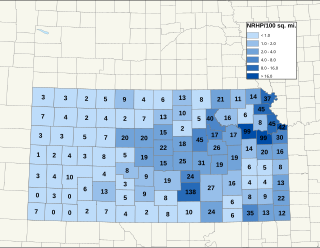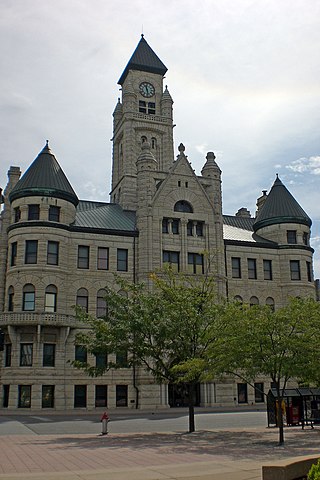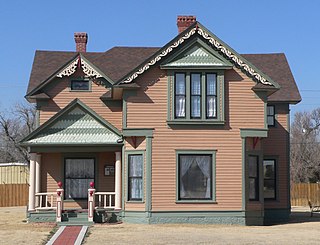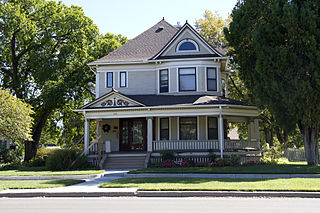
Kansas is a landlocked state in the Midwestern region of the United States. It borders Nebraska to the north; Missouri to the east; Oklahoma to the south; and Colorado to the west. Kansas is named after the Kansas River, in turn named after the Kansa people. Its capital is Topeka, and its most populous city is Wichita, however the largest urban area is the bi-state Kansas City, MO–KS metropolitan area.

Wichita is the most populous city in the U.S. state of Kansas and the county seat of Sedgwick County. As of the 2020 census, the population of the city was 397,532. The Wichita metro area had a population of 647,610 in 2020. It is located in south-central Kansas on the Arkansas River.

Caroline Amelia Nation, often referred to by Carrie, Carry Nation, Carrie A. Nation, or Hatchet Granny, was an American who was a radical member of the temperance movement, which opposed alcohol before the advent of Prohibition. Nation is noted for attacking alcohol-serving establishments with a hatchet. She married David Nation in 1874. She was previously known by either her birth name, Carrie Moore and, after her first marriage in 1867, as Carrie Gloyd.

The National Register of Historic Places in the United States is a register including buildings, sites, structures, districts, and objects. The Register automatically includes all National Historic Landmarks as well as all historic areas administered by the U.S. National Park Service. Since its introduction in 1966, more than 90,000 separate listings have been added to the register.

There are over 1,600 buildings, sites, districts, and objects in Kansas listed on the National Register of Historic Places in Kansas. NRHP listings appear in 101 of the state's 105 counties.

The architecture of Kansas City encompasses the metropolitan area, anchored by Kansas City, Missouri (KCMO). Major buildings by some of the world's most distinguished architects and firms include McKim, Mead and White; Jarvis Hunt; Wight and Wight; Graham, Anderson, Probst and White; Hoit, Price & Barnes; Frank Lloyd Wright; the Office of Mies van der Rohe; Barry Byrne; Edward Larrabee Barnes; Harry Weese; and Skidmore, Owings & Merrill.
Campbell House, or The Campbell House or variations, may refer to:

Grinter Place is a house on the National Register of Historic Places above the Kansas River in the Muncie neighborhood of Kansas City, Kansas.
Kelly House may refer to:

The Kansas Aviation Museum is a museum located in Wichita, Kansas, United States, near 31st South and George Washington Blvd. The building was the former Wichita Municipal Airport terminal from 1935 to 1954. In February of 2024, the Wichita City Council approved an honorary over-naming of George Washington Blvd. as "Air Capital Blvd", recognizing the impact that Wichita makes in aviation.
The Deer Creek/Bryson Paddock Sites are the remains of 18th century fortified villages of the Wichita tribe located along the Arkansas River in Kay County, Oklahoma.

Old Cowtown Museum is an accredited history museum located in Wichita, Kansas, United States. It is located next to the Arkansas River in central Wichita. The Museum was established in 1952, and is one of the oldest open-air history museums in central United States with 54 historic and re-created buildings, including a period farm and out-buildings, situated on 23 acres of land off the original Chisholm Trail. Cowtown is a combination of attraction, museum, living history site, and historic preservation project. The Historic Wichita Cowtown, Inc. Board, a 501(c)(3) not-for-profit institution, works with the City of Wichita to further the Museum and its mission.

The Wichita-Sedgwick County Historical Museum is a non-profit 501(c)(3) organization dedicated to preserving and presenting the local history of Wichita and Sedgwick County, Kansas, United States. It is located at 204 South Main, and east of the former Wichita Public Library.

The Seth E. Ward Homestead, also known as Ward House or Frederick B. Campbell Residence is a historic home located in the Country Club District, Kansas City, Missouri. It was designed by Asa Beebe Cross and built in 1871. It is a two-story, "T"-plan, vernacular Greek Revival style brick dwelling. It features a single story, full-width front verandah. It was a home of Seth E. Ward.

The Allen House is a Prairie Style home in Wichita, Kansas, designed by Frank Lloyd Wright in 1915 for former Kansas Governor Henry Justin Allen and his wife, Elsie.

Riverside is a neighborhood in Wichita, Kansas, United States. A mostly residential area located between the Arkansas and Little Arkansas Rivers, it is home to several of the city's museums and large parks.

The William B. and Julia Washington House, at 112 N. 3rd St. in Leoti in Wichita County, Kansas. It was completed in 1892. It was listed on the National Register of Historic Places in 2014.
Charles W. Terry (1847–1931), commonly known as C.W. Terry, was an architect based in Wichita, Kansas. Several works credited to him and partnerships he was in are listed on the National Register of Historic Places.

The Guldner House, at 1919 W. Douglas in Wichita in Sedgwick County, Kansas is a Queen Anne style house built to a design by the Radford Architectural Company. It was listed on the National Register of Historic Places in 2010.















